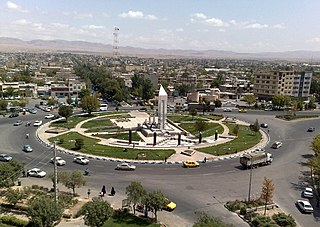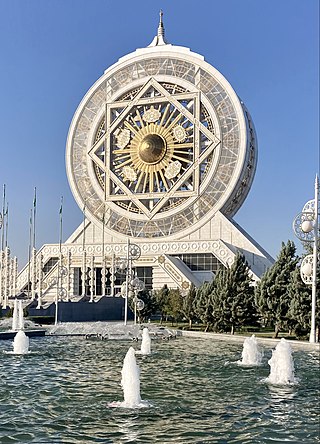
Quchan is a city in the Central District of Quchan County, Razavi Khorasan province, Iran, serving as capital of both the county and the district. It is approximately 97 km south of the border city of Ashgabat, capital city of neighboring Turkmenistan.

Saparmurat Turkmenbashy Olympic Stadium was a multi-purpose stadium in Ashgabat, Turkmenistan, that stood on the site now occupied by the new Olympic Stadium, built between 2013 and 2017.

Monument of Neutrality is a monument originally located in Ashgabat, Turkmenistan. In 2010, it was moved to the suburbs. The three-legged arch, which became known locally as "The Tripod", was 75 metres (246 ft) tall and was built in 1998 on the orders of the president of Turkmenistan, Saparmurat Niyazov, to commemorate the country's official position of neutrality. It cost $12 million to construct. The monument was topped by a 12-metre (39 ft) tall gold-plated statue of Niyazov which rotated to always face the sun. The arch was located in central Ashgabat where it dominated the skyline, being taller than the nearby Presidential Palace. The statue was illuminated at night. The arch featured a panoramic viewing platform which was a popular attraction for visitors.

Anau is a city in Turkmenistan. Until 20 December 2022 it was the capital of Ahal Province. It is situated 8 km southeast of Ashgabat, to which it is connected via the M37 highway.

Presidential Palace is the official residence and principal workplace of the president of Turkmenistan, located on Independence Square in the capital city of Ashgabat in Turkmenistan. This building was built in May 2011, replacing the role of the smaller Oguzhan Presidential Palace, built in 1997 located nearby.
Shirvan is a city in the Central District of Shirvan County, North Khorasan province, Iran, serving as capital of both the county and the district. The city has been significant industrially with sugar beet factories. It is also significant historically, geographically (Honameh), and anthropologically.

The "Independence Monument" is a monument located in Ashgabat, Turkmenistan. The design of this building was inspired by traditional Turkmen tents and the traditional headgear worn by Turkmen girls. Elements of the building commemorate the independence date of Turkmenistan, 27 September. These elements include a 91-metre (299 ft) reinforced concrete tower with a 27-metre (89 ft) high golden gilt steel construction on top of the tower, along with an observation terrace with a diameter of 10 metres (33 ft). Within the building, there are exhibition halls where important works of art representing Turkmenistan history are displayed. The Monument of Independence sits on a total area of 84,500 m2 (910,000 sq ft), surrounded by green landscaping that encompasses a cascaded pool and 27 heroic statues of Turkmen leaders, centered on a golden statue of Saparmurat Niyazov.
The Museum of Fine Arts is an art museum in Ashgabat, Turkmenistan. It was founded in 1927 by Russian sculptor A.A Karelin and in 1939 it attained the status of the Museum of Fine Arts.
The Exhibition Hall of the Ministry of Culture is an important government building in Ashgabat, Turkmenistan. It is operated by the Turkmen Ministry of Culture and regularly hosts displays including exhibitions, conferences and theatrical and drama performances in the arts. The three floors building was erected in 2005, by French company Bouygues.

Ertuğrul Gazi Mosque or Ärtogrul Gazy Mosque is a mosque in Ashgabat, Turkmenistan. It is a prominent landmark in Ashgabat with its four minarets and a central dome and has a lavish interior decoration with fine stained glass windows.

The Ashgabat Flagpole is a flagpole in Ashgabat, Turkmenistan. It is 133 metres tall, making it the eighth tallest free–standing and ninth tallest flagpole in the world. It was erected on 29 June 2008. It was the tallest free–standing flagpole in the world until being surpassed by the 162 m (531 ft) National Flagpole in Azerbaijan on 1 September 2010. The Vice-president of the Guinness Book of World Records at the time, Greig Glenday, came to Ashgabat as a witness, and handed over a certificate of the record.

Alem Cultural and Entertainment Center is a cultural center in Ashgabat, Turkmenistan. It was officially opened to the public on May 18, 2012. The opening ceremony was attended by the President of Turkmenistan, Gurbanguly Berdimuhamedov.
Ashgabat railway station is the main railway station in Ashgabat, Turkmenistan. It was originally built in 1888, but had to be rebuilt after an earthquake in 1948. The station is operated by the Türkmendemirýollary.

The Wedding Palace is a civil registry building in Ashgabat, Turkmenistan. It was constructed by Turkish company Polimeks. It was built in 2011, commissioned by the Government of Turkmenistan.

Ashgabat Fountain is a fountain complex located in Ashgabat, Turkmenistan. The complex currently holds two entries in the Guinness Book of Records - one for its size and one for "Most Fountain Pools in a Public Place." Constructed by the Turkish company Polimeks in 2008, the Ashgabat Fountain is located on the road leading from Ashgabat Airport to the city center of Ashgabat.
The Ashgabat cinema is a movie theater in Ashgabat. The theater is on Magtymguly Avenue near the Kopetdag Stadium. Opened on June 29, 2011, it is the first 3D cinema in Turkmenistan.
The Ashgabat Sports Complex Velodrome is a velodrome constructed in Ashgabat, Turkmenistan. It was built by Turkish construction company Polimeks for the 2017 Asian Indoor and Martial Arts Games. The track is 250 meters long and 7,1 meters wide. The construction materials used fabric from Finland. The total area of the five-storey building of 61,000 m2. Rostrum accommodate up to 6000 spectators, there are VIP loggia and sector for press. Among the infrastructure facilities for athletes: massage room, sauna, restaurant for 48 people, 9 cafes at 447 locations and 13 diners rooms.

The contemporary borders of the nations of Afghanistan and Turkmenistan are the products of The Great Game in Central Asia between the British and Russian Empires. As a result, the two countries have some cultural ties, with Afghanistan having 1.2 million Turkmen, the third largest Turkmen population behind Iran and Turkmenistan.
The Ashgabat Botanical Garden in Ashgabat is the oldest botanical garden in Turkmenistan. The name Ashgabat literally means "city of love or city of devotion." Turkmenistan is found in the Central Asia. It is bordered by Kazakhstan to the northwest, Uzbekistan to the north and east, Afghanistan to the southeast, Iran to the south and southwest and the Caspian Sea to the west. Entrance to the botanical garden is located in the eastern side of Ashgabat on the territory of the academic sciences of Turkmenistan between streets 2029 and Tagta.

The Walk of Health is a 36-kilometre (22 mi) long concrete walkway that runs alongside the Kopet Dag mountain range in south Ashgabat, Turkmenistan, near the Iran–Turkmenistan border. The first 8 km (5.0 mi) of the path was constructed in 1999 by dictator Saparmurat Niyazov, with the intent of encouraging citizens to be healthy. It officially opened on 2 January 2000. Until Niyazov's death, he required his ministers to walk the walkway once every year.












